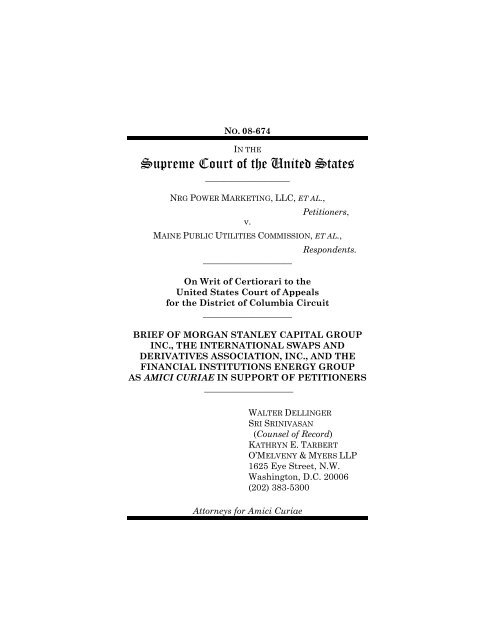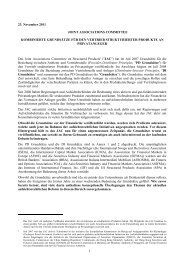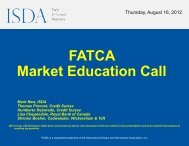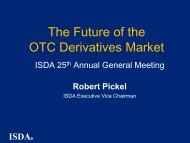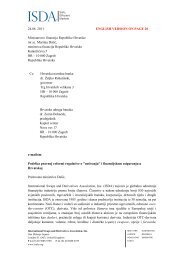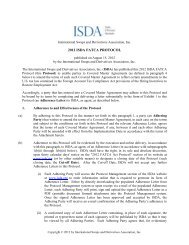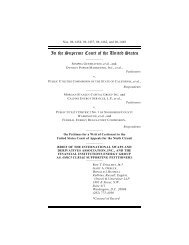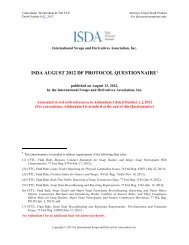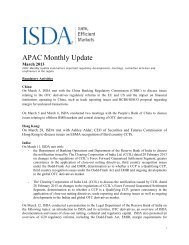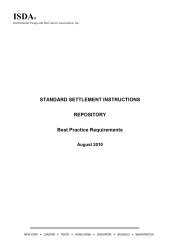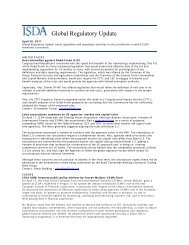NRG POWER MARKETING, LLC, ET AL., Petitioners, v ... - ISDA
NRG POWER MARKETING, LLC, ET AL., Petitioners, v ... - ISDA
NRG POWER MARKETING, LLC, ET AL., Petitioners, v ... - ISDA
You also want an ePaper? Increase the reach of your titles
YUMPU automatically turns print PDFs into web optimized ePapers that Google loves.
NO. 08-674IN THESupreme Court of the United States___________________<strong>NRG</strong> <strong>POWER</strong> <strong>MARK<strong>ET</strong>ING</strong>, <strong>LLC</strong>, <strong>ET</strong> <strong>AL</strong>.,v.<strong>Petitioners</strong>,MAINE PUBLIC UTILITIES COMMISSION, <strong>ET</strong> <strong>AL</strong>.,____________________Respondents.On Writ of Certiorari to theUnited States Court of Appealsfor the District of Columbia Circuit____________________BRIEF OF MORGAN STANLEY CAPIT<strong>AL</strong> GROUPINC., THE INTERNATION<strong>AL</strong> SWAPS ANDDERIVATIVES ASSOCIATION, INC., AND THEFINANCI<strong>AL</strong> INSTITUTIONS ENERGY GROUPAS AMICI CURIAE IN SUPPORT OF P<strong>ET</strong>ITIONERS____________________W<strong>AL</strong>TER DELLINGERSRI SRINIVASAN(Counsel of Record)KATHRYN E. TARBERTO’MELVENY & MYERS LLP1625 Eye Street, N.W.Washington, D.C. 20006(202) 383-5300Attorneys for Amici Curiae
iTABLE OF CONTENTSPageINTEREST OF AMICI CURIAE .............................. 1INTRODUCTION AND SUMMARY OFARGUMENT........................................................ 4ARGUMENT ............................................................. 8I. THE COURT OF APPE<strong>AL</strong>S’ NON-PARTY EXCEPTION TO MOBILE-SIERRA WOULD ESSENTI<strong>AL</strong>LYNULLIFY THIS COURT’S DECI-SION MERELY TWO TERMS AGOIN MORGAN STANLEY .......................... 8A. Morgan Stanley Preserved andReaffirmed the Centrality ofContract Stability under theFederal Power Act ............................... 9B. The Decision Below Is Irreconcilablewith Morgan Stanley ................. 11II. THE COURT OF APPE<strong>AL</strong>S’ DECI-SION WILL HARM CONSUMERSBY IMPEDING THE EFFICIENTOPERATION OF THE WHOLE-S<strong>AL</strong>E <strong>POWER</strong> MARK<strong>ET</strong> ....................... 14CONCLUSION........................................................ 24
iiTABLE OF AUTHORITIESPageCASESASARCO, Inc. v. FERC,777 F.2d 764 (D.C. Cir. 1985)............................ 17Boston Edison Co. v. FERC,233 F.3d 60 (1st Cir. 2000) ................................ 16Cities of Bethany v. FERC,727 F.2d 1131 (D.C. Cir. 1984).......................... 16Conn. Dep’t of Pub. Util. Control v.FERC, 2009 WL 1754607(D.C. Cir. June 23, 2009) ................................... 23Cutter v. Wilkinson,544 U.S. 709 (2005)............................................ 22Elec. Consumers Res. Council v. FERC,407 F.3d 1232 (D.C. Cir. 2005).......................... 16F. Hoffmann-La Roche Ltd. v.Empagran S.A.,542 U.S. 155 (2004)............................................ 22FPC v. Sierra Pac. Power Co.,350 U.S. 348 (1956).......................................... 5, 8Kan. Cities v. FERC,723 F.2d 82 (D.C. Cir. 1983).............................. 17Morgan Stanley Capital Group Inc. v.Public Utility District No. 1 ofSnohomish County,128 S. Ct. 2733 (2008).................................passimPermian Basin Area Rate Cases,390 U.S. 747 (1968)............................................ 17Sunray Mid-Continent Oil Co. v. FPC,364 U.S. 137 (1960)............................................ 11
iiiTABLE OF AUTHORITIESPageTransmission Access Policy StudyGroup v. FERC,225 F.3d 667 (D.C. Cir. 2000)............................ 15United Gas Pipe Line Co. v. MemphisLight, Gas & Water Division,358 U.S. 103 (1958).......................................15, 19United Gas Pipe Line Co. v. Mobile GasServ. Corp.,350 U.S. 332 (1956).......................................... 5, 8Williston Basin Interstate Pipeline Co.v. FERC,519 F.3d 497 (D.C. Cir. 2008)............................ 19STATUTES16 U.S.C. § 824d(a).................................................... 516 U.S.C. § 824e(a).................................................... 516 U.S.C. § 791a ........................................................ 4ADMINISTRATIVE MATERI<strong>AL</strong>SCitizens Power & Light Corp., 48F.E.R.C. 61,210 (Aug. 8, 1989)..................18, 20Duke Energy Carolinas, <strong>LLC</strong>, 123F.E.R.C. 61,201 (2008).................................... 20Morgan Stanley Capital Group, Inc., 69F.E.R.C. 61,175 (Nov. 8, 1994) ......................... 1Morgan Stanley Capital Group, Inc.,No. ER94-1384-029 (June 26, 2001).................... 1Nev. Power Co. & Sierra Pac. Power Co.v. Enron Power Mktg., Inc., 101F.E.R.C. 63,031 (Dec. 19, 2002) ..................... 21Nev. Power Co. v. Duke Energy Trading& Mktg. L.L.C., 99 F.E.R.C. 61,047(2002).................................................................. 16
ivTABLE OF AUTHORITIESPageNev. Power Co. v. Enron Power Mktg.,Inc., 103 F.E.R.C. 61,353 (2003) .................... 12Pub. Utils. Comm’n of Cal. v. Sellers ofLong Term Contracts, 99 F.E.R.C. 61,087 (2002)................................................... 12OTHER AUTHORITYJoseph M. Perrillo, Corbin on Contracts(2005).................................................................. 23
BRIEF OF MORGAN STANLEY CAPIT<strong>AL</strong> GROUPINC., THE INTERNATION<strong>AL</strong> SWAPS ANDDERIVATIVES ASSOCIATION, INC., AND THEFINANCI<strong>AL</strong> INSTITUTIONS ENERGY GROUPAS AMICI CURIAE IN SUPPORT OF P<strong>ET</strong>ITIONERSMorgan Stanley Capital Group Inc., the InternationalSwaps and Derivatives Association, Inc., andthe Financial Institutions Energy Group respectfullysubmit this brief as amici curiae in support of thepetitioners. 1INTEREST OF AMICI CURIAEMorgan Stanley Capital Group Inc. (MorganStanley), the commodities division of MorganStanley, is a “power marketer”: an entity with regulatoryapproval from the Federal Energy RegulatoryCommission (FERC or the Commission) to buy andsell, at market-based rates, wholesale electricity thatit does not produce. Morgan Stanley was one of thefirst entities approved to sell power in this manner,having initially received its market-based authorityin 1994 and then having repeatedly received authorizationthereafter. See Morgan Stanley CapitalGroup, Inc., 69 F.E.R.C. 61,175 (Nov. 8, 1994), seealso, e.g., Morgan Stanley Capital Group, Inc., No.1 Pursuant to Rule 37.6, counsel for amici curiae state thatno counsel for a party authored this brief in whole or in part,and no counsel or party made a monetary contribution intendedto fund the preparation or submission of this brief. No personor entity other than amici curiae, their members, or their counselhas made a monetary contribution to the preparation orsubmission of this brief. The parties have filed letters of consentto the filing of this brief. Letters reflecting such consenthave been filed with the Clerk.
2ER94-1384-029 (June 26, 2001) (application filedNovember 8, 2000).The International Swaps and Derivatives Association,Inc. (<strong>ISDA</strong>), which represents participants inthe privately negotiated derivatives industry, is thelargest global financial trade association by numberof member firms. <strong>ISDA</strong> was chartered in 1985 andtoday has over 825 member institutions from 57countries on six continents. These members includemost of the world’s major institutions that deal inprivately negotiated derivatives, as well as many ofthe businesses, governmental entities and other endusers that rely on over-the-counter derivatives tomanage efficiently the risks inherent in their coreeconomic activities. Since its inception, <strong>ISDA</strong> haspioneered efforts to identify and reduce the sourcesof risk in the derivatives and risk management business.The Financial Institutions Energy Group (FIEG)is a group of banks and other financial institutions,all of which play a vital role in the electric utility industry.The businesses of FIEG members (and theiraffiliates) as they relate to the energy sector are verydiverse. They are directly involved in the purchaseand sale of electric energy, capacity, and ancillaryservices, and many, like Morgan Stanley, are powermarketers with market-based rate authority. Theyare also involved in a wide array of other businessesthat are only incidentally related to the electric industry.For example, FIEG members may act asmarket-making dealers, participants in physicallyand financially settled derivative transactions designedto hedge certain counterparty risk or to establisha proprietary position in the market, arrangers
3of loan facilities, and underwriters of debt and equitysecurities.Members of <strong>ISDA</strong> and FIEG are substantial participantsin the market for wholesale electric power.Some members own interests in companies that produceelectric power and sell it in the wholesale market.Some members own interests in retail distributioncompanies that purchase power in the wholesalemarket and distribute it to end users. Predominantly,however, members of these amici, like MorganStanley, operate as power marketers in thewholesale market; they contract with power producers,distribution companies, and other power marketersto buy or sell wholesale power that will ultimatelybe produced, resold, or distributed by others.Power marketers like Morgan Stanley and themembers of <strong>ISDA</strong> and FIEG play an extremely importantrole in wholesale power markets. Their expertiseand extensive trading operations allow themto mitigate the financial risks that power manufacturersor distributors would otherwise have to incurin producing or distributing power. By assembling adiverse portfolio of contractual obligations to buyand sell power at different times and differentprices, power marketers can insulate themselvesfrom many of the risks of temporary price volatility,which are inherent in the energy market, as well aslonger term unfavorable price trends. By contractingwith producers and distributors of power, thesemarketers also allow producers and distributors toavoid those risks.Unlike power producers, which generally participatein the energy market as sellers, and distribu-
4tion companies, which participate as buyers, powermarketers tend over the long term to be neither netsellers nor net purchasers of power. Consequently,they have no vested interest in rules that systematicallyfavor either sellers or buyers. Their interest,instead, is in rules that ensure that the market operateseffectively. They therefore are especially wellsuited to address the implications of the court of appeals’decision below for the effective functioning ofthe market for wholesale energy sales and purchases.Both <strong>ISDA</strong> and FIEG accordingly participated asamici curiae in support of petitioners in MorganStanley Capital Group Inc. v. Public Utility DistrictNo. 1 of Snohomish County, 128 S. Ct. 2733 (2008).Morgan Stanley of course was a petitioner in thatcase. Morgan Stanley, <strong>ISDA</strong>, and FIEG now participateas amici curiae in this case principally to explainthat, whereas the Court’s recent decision twoTerms ago in Morgan Stanley strongly reaffirmedthe central role of contractual stability in securingthe effective functioning of the market for wholesalepower, an affirmance of the court of appeals in thiscase would essentially negate the decision in MorganStanley and the vital protection of contractual stabilityon which the decision is grounded.INTRODUCTION ANDSUMMARY OF ARGUMENTUnder the Federal Power Act (FPA), 16 U.S.C.§§ 791a et seq., FERC possesses authority to regulatethe transmission and sale of wholesale electricity.The FPA prescribes that all wholesale energy ratesmust be “just and reasonable,” and any rate failing
5to qualify as “just and reasonable” is “declared to beunlawful.” 16 U.S.C. § 824d(a). The FPA grantsFERC authority to review, on its own initiative or inresponse to a complaint, whether existing rates complywith the “just and reasonable” standard, and todetermine and fix by order a “just and reasonablerate” upon concluding that an existing rate is “unjust,unreasonable, unduly discriminatory or preferential.”16 U.S.C. § 824e(a).The degree of latitude possessed by FERC tomodify an existing rate on the ground that it fails toqualify as “just and reasonable” varies depending onwhether the rate was established unilaterally by tariffor instead by a negotiated contract. The Mobile-Sierra doctrine, see United Gas Pipe Line Co. v. MobileGas Serv. Corp., 350 U.S. 332 (1956); FPC v. SierraPac. Power Co., 350 U.S. 348 (1956), establishesa presumption that wholesale energy contracts negotiatedby sophisticated parties produce just and reasonablerates. Contract rates, that is, presumptivelyare “just and reasonable,” and may be set aside byFERC only in narrow situations in which their continuedenforcement would “violate[] the public interest.”Morgan Stanley, 128 S. Ct. at 2739. In thecase of a rate established unilaterally by tariff,FERC retains greater latitude to set aside the rateas unjust and unreasonable “if it results in an unfairrate of return, not just if it violates the public interest.”Id.Those two forms of review—the more stringentpublic interest standard for contract rates and the“ordinary” just-and-reasonable standard for noncontractrates—each constitute applications to theirdistinct contexts of the FPA’s overarching “just and
6reasonable” standard. Id. at 2740. The Mobile-Sierra public-interest standard therefore “refers tothe differing application of th[e] just-and-reasonablestandard to contract rates.” Id.This Court strongly reaffirmed the vitality of theMobile-Sierra presumption for contract rates in itsdecision two Terms ago in Morgan Stanley. In doingso, the Court emphasized “the important role of contractsin the FPA” and the FPA’s “recogni[tion] thatcontract stability ultimately benefits consumers.”Id. at 2749. Conversely, the Court explained, “uncertaintiesregarding rate stability and contractsanctity can have a chilling effect on investmentsand a seller’s willingness to enter into long-term contractsand this, in turn, can harm customers in thelong run.” Id. (quoting Market-Based Rates forWholesale Sales of Electric Energy, Capacity andAncillary Services by Public Utilities, 72 Fed. Reg.39,904, 39,906–07 (July 20, 2007)).The court of appeals below confined the Mobile-Sierra presumption to rate challenges brought by acontracting party, holding the “Mobile-Sierra doctrinesimply does not apply” when “a rate challengeis brought by a non-contracting third party.” Pet.App. 22a. That approach, if affirmed, would substantiallyundermine, if not completely destroy, thevital protection of contract stability secured by therecent reaffirmation of Mobile-Sierra in MorganStanley. The court of appeals’ decision enables anyaffected third party to challenge and potentially invalidateany wholesale energy contract as “unjustand unreasonable” without regard to the “public interest”standard, thus allowing any third party to
7seek to set aside a contract rate free from the presumptionof validity demanded by Mobile-Sierra.Indeed, the court of appeals’ decision below affectsthe sanctity of the very contracts at issue inMorgan Stanley itself. One of the respondents in theMorgan Stanley case, the Nevada Bureau of ConsumerProtection, has argued before FERC on remandfrom this Court’s decision that, under the D.C.Circuit’s decision below, it can freely challenge therates in the Morgan Stanley contracts unencumberedby the Mobile-Sierra presumption. TheCourt’s opinion in Morgan Stanley, however, nowheresuggests that the public interest standard itordered the Commission to apply was applicable onlyto the contracting respondents. On the contrary, theCourt emphasized that “[t]here is only one statutorystandard for assessing wholesale electricity rates”—the just-and-reasonable standard—and when thatstandard is applied to contracted-for rates, it permitsthe Commission to overturn only rates that would“seriously harm the public interest.” MorganStanley, 128 S. Ct. at 2745, 2747. The D.C. Circuit’sdecision varies the application of the statutory standard,to the very same rate, based on who asksFERC to apply it. There is no justification for applyinga varied interpretation to the fixed terms of thestatute in that manner.Such an approach is particularly problematic inthe context of the FPA. Contracts play an integralrole in that statutory scheme, and contract stabilityis essential to the wholesale energy markets towhich the statute applies. The uncertainty createdby the court of appeals’ approach would thoroughlyundermine contractual integrity, with substantial
8adverse implications for the effective functioning ofthose markets. In particular, the court of appeals’approach would (i) make it very difficult to attractsufficient capital to build and maintain the expansive(and expensive) infrastructure necessary to produce,transport, and deliver energy; (ii) encouragepower marketers, who depend on the enforceabilityof their contracts to make a profit, to shift their capitalto other markets with lesser levels of costs andrisks; and (iii) discourage power sellers from enteringinto long-term agreements precisely when theircapacity and price certainty are most needed by buyers.The result ultimately would be to harm the consumersthat rely on the wholesale energy market forthe power they use every day.ARGUMENTI. THE COURT OF APPE<strong>AL</strong>S’ NON-PARTYEXCEPTION TO MOBILE-SIERRAWOULD ESSENTI<strong>AL</strong>LY NULLIFY THISCOURT’S DECISION MERELY TWOTERMS AGO IN MORGAN STANLEYTwo Terms ago, this Court in Morgan Stanleystrongly reaffirmed its landmark decisions in UnitedGas Pipe Line Co. v. Mobile Gas Service Corp., 350U.S. 332 (1956), and FPC v. Sierra Pacific Power Co.,350 U.S. 348 (1956), and the centrality of contractualintegrity to the operation of the FPA. But that recentvictory—for the petitioners in that case, for theeffective functioning of wholesale energy markets,and ultimately for the consumers who rely onthem—has been put substantially at risk by thecourt of appeals’ decision below. The D.C. Circuit’sdecision cannot be reconciled with this Court’s
9precedent or with the terms of the FPA, which establishone—and only one—standard governing the reviewof rates established by contract, regardless ofthe identity of the party bringing a challenge.A. Morgan Stanley Preserved and Reaffirmedthe Centrality of ContractStability under the Federal PowerActMorgan Stanley arose out of a dispute involving,inter alia, a long-term wholesale power contract betweenMorgan Stanley and respondent Public UtilityDistrict No. 1 of Snohomish County Washington(Snohomish), during the 2000-2001 crisis in the energymarkets in the Western States. Eventually, theprevailing market rates for short-term power fell belowthe rate established in Snohomish’s contractwith Morgan Stanley. Snohomish then filed a complaintwith FERC, seeking to set aside the terms ofits contract with Morgan Stanley. Other companieslikewise challenged contracts they made during thecrisis to purchase power. Certain non-contractingentities and individuals, including the Nevada AttorneyGeneral, Bureau of Consumer Protection(BCP), and a Senator from the State of Washington,sought to intervene before the Commission on thechallengers’ behalf. FERC rejected those challenges,emphasizing the importance of contract stability underthe FPA. The Ninth Circuit reversed, holdingthat the Mobile-Sierra presumption was inapplicablein those circumstances for a number of reasons. SeeMorgan Stanley, 128 S. Ct. at 2743-45.This Court largely reversed the decision of theNinth Circuit. The Court began by reiterating that,
10“[u]nder the Mobile-Sierra doctrine, [FERC] mustpresume that the rate set out in a freely negotiatedwholesale-energy contract meets the ‘just and reasonable’requirement imposed by law,” and it mayrevise those rates only if they place “an excessiveburden on consumers or otherwise seriously harmthe public interest.” Id. at 2737, 2750.The Court concluded that the Ninth Circuit hadfailed to abide by the Mobile-Sierra rule, and hadgiven “short shrift to the important role of contractsin the FPA” in several respects. Id. at 2749.First, by limiting application of Mobile-Sierra toinstances in which FERC had pre-approved themarket-based contract rates, the Ninth Circuit haderroneously “read Sierra as the equivalent of an estoppeldoctrine” rather than “a definition of what itmeans for a rate to satisfy the just-and-reasonablestandard in the contract context.” Id. at 2746 (internalquotation marks omitted). Second, by limitingthe application of Mobile-Sierra where there was apossibility of market dysfunction, the Ninth Circuithad “enabl[ed] sophisticated parties who weatheredmarket turmoil by entering long-term contracts torenounce those contracts once the storm ha[d]passed,” thus “reduc[ing] the incentive to concludesuch contracts in the future” and “undermin[ing] therole of contracts in the FPA’s statutory scheme.” Id.at 2747. Third, by adopting a “zone of reasonableness”test to evaluate a buyer’s challenge that ratesare too high, the Ninth Circuit had failed “to accordan adequate level of protection to contracts.” Id. at2747, 2749. As this Court explained, “[a] presumptionof validity that disappears when the rate is
11above marginal cost is no presumption of validity atall.” Id. at 2748.Finally, the Court turned to two issues on whichit concluded remand to the Commission was required:(i) whether the challenged agreements imposedan excessive burden on customers “down theline,” and (ii) whether any party had engaged “insuch extensive unlawful market manipulation” as toaffect negotiation of the contract rates. 128 S. Ct. at2747, 2749-51. The Court remanded the case for theCommission to “amplify or clarify” its findings onthose two issues. Id.B. The Decision Below Is Irreconcilablewith Morgan StanleyThe Court’s decision in Morgan Stanley reaffirmsa long line of precedent in which this Court has recognizedthat Congress “built the regulatory system”of the National Gas Act and FPA “on a foundation ofprivate contracts.” Sunray Mid-Continent Oil Co. v.FPC, 364 U.S. 137, 154 (1960). The decision of theD.C. Circuit in this case puts that foundation, includingthe outcome in Morgan Stanley itself, atrisk.The court of appeals’ “third-party exception” tothe presumption of reasonableness would effectivelyswallow the Mobile-Sierra rule. By misreading Mobile-Sierraas “depart[ing] from the usual ‘just andreasonable’ standard,” the court of appeals misunderstoodthe FPA to permit virtually anyone but acontracting party—including individual end consumers,corporations, governmental entities, andstate regulators—to attack contractually negotiatedrates as unjust and unreasonable without any pre-
12sumption of validity. See Pet. App. 22a (explainingthat “[i]t goes without saying that a contract cannotbind a nonparty”) (internal quotation marks omitted).The decision thus eliminates any semblance ofthe contractual integrity that this Court has longrecognized to be integral under the FPA. A contractingparty desiring to set aside a negotiated ratewithout having to overcome the Mobile-Sierra presumptionneed only find some non-contracting partywilling to take up the challenge.Indeed, one of the respondents in the MorganStanley case itself has argued that the case shouldhave been decided differently under the rule establishedby the court of appeals in this case. Several ofthe parties that opposed the contracts at issue inMorgan Stanley were non-parties to the agreements.See, e.g., Nev. Power Co. v. Enron Power Mktg., Inc.,103 F.E.R.C. 61,353, at 62,388-89 (2003) (discussingSenator’s request for rehearing); Pub. Utils.Comm’n of Cal. v. Sellers of Long Term Contracts, 99F.E.R.C. 61,087, at 61,377, 61,382-83 (2002) (discussingcomplaints filed by the Public UtilitiesCommission of the State of California and the CaliforniaElectricity Oversight Board), reh’g denied, 100F.E.R.C. 61,098 (2002). One of those non-parties,the Office of the Nevada Attorney General, Bureauof Consumer Protection (Nevada BCP), was a respondentbefore this Court. See Morgan Stanley, 127S. Ct. at 2736.This Court’s mandate in Morgan Stanley madeplain that the Commission on remand was to applythe Mobile-Sierra public-interest standard to the
13contracts at issue in the case. 2 The Nevada BCPnonetheless has argued on remand that the D.C.Circuit’s opinion below “precludes application of theMobile-Sierra presumption of justness and reasonablenessin evaluating the Nevada BCP’s challenge”to the very same contracts. Nevada Attorney General,Bureau of Consumer Protection Answer to Snohomish’sCross-Motion for Procedures on Remand ofMorgan Stanley at 3-4 (Dec. 9, 2008) (Nevada BCPAnswer). The BCP accordingly asserted that theCommission could, “based on its findings to date,conclude that the rates included in the . . . Nevadacontracts [before the Commission] are unjust andunreasonable” and “order refunds” based on “the differencebetween the contract rates and just and reasonablerates.” Id. at 4.The Commission rejected Nevada’s argument as“premature,” and “strongly encourage[d] all partiesin th[e] matter to settle their disputes.” FERC Orderon Remand at 15 n.63 & 18, No. EL02-28-006, et al.(Dec. 18, 2008). The BCP, however, filed a petitionfor rehearing, arguing that the paper hearing orderedby FERC “was unnecessary and inappropriate”in that the “Commission erred in failing to specifythat, pursuant to Maine PUC, the Mobile-Sierra presumptionof justness and reasonableness does notapply to the Nevada BCP’s challenge to the NV Energycontracts at issue in [Morgan Stanley].” Re-2 See, e.g., Morgan Stanley, 128 S. Ct. at 2750 (Commissionon remand to consider whether increase in rates during thecrisis was “so great that, even taking into account the desirabilityof fostering market-stabilizing long-term contracts, therates impose an excessive burden on consumers or otherwiseseriously harm the public interest”).
14quest for Rehearing of the Office of the Nevada AttorneyGeneral, Bureau of Consumer Protection at 2,7 (Jan. 20, 2009). FERC has yet to rule on the petitionfor rehearing.The Nevada BCP’s position in Morgan Stanleyvividly illustrates the mischief that the decision belowwould enable. Contrary to the argument of theBCP and the decision of the court of appeals below,there is no basis for concluding that the justness andreasonableness of a contract rate could depend uponwho is challenging it. As this Court emphasized inMorgan Stanley, “[t]here is only one statutory standardfor assessing wholesale electricity rates,” i.e.,“the just-and-reasonable standard.” 128 S. Ct. at2745. And there is only one “definition of what itmeans for a rate to satisfy the just-and-reasonablestandard in the contract context”: the public interestrequirement of Mobile-Sierra. Id. That standardapplies uniformly when assessing the validity of acontracted-for rate, “regardless of when the contractis reviewed,” id., and regardless of the identity of theparty bringing a challenge.II.THE COURT OF APPE<strong>AL</strong>S’ DECISIONWILL HARM CONSUMERS BY IMPEDINGTHE EFFICIENT OPERATION OF THEWHOLES<strong>AL</strong>E <strong>POWER</strong> MARK<strong>ET</strong>The Mobile-Sierra presumption rests on the intuitionthat markets generally cannot operate efficientlyunless contracting parties have confidencethat contractual commitments will be enforced. Theneed for contract stability is especially critical in themarket for wholesale power, which requires clear,stable, and enforceable contract rights for its very
15existence. Without that guarantee, the market (i)will not be able to attract sufficient capital to buildand maintain the extensive and expensive infrastructurerequired for the production, transportation,and delivery of energy; (ii) will not be able tosecure the participation of power marketers, whomake the market more competitive; and (iii) will notbe able to ensure that energy is provided to the publicwhen the need for such power is at its greatest. Amarket operating under these constraints will fail toprovide the service required by consumers who relyon it for their daily energy needs.1. The contractual stability secured by Mobile-Sierra is critical to the wholesale power market, firstand foremost, because the massive investmentsneeded to build and maintain the infrastructure forthe production, transportation, and delivery of powerrequire that market participants have confidencethat their agreements will remain binding in the future,even if one of the parties comes to conclude inhindsight that the original deal was improvident. Asthis Court recognized in United Gas Pipe Line Co. v.Memphis Light, Gas & Water Division, 358 U.S. 103(1958), without reliable legal protection of energyproducers’ contract rights, “the maintenance and expansionof their systems through equity and debt financingwould become most difficult, if not impossible.”Id. at 113. Since the enactment of the FPA,“[e]conomies of scale have justified the constructionof large . . . generation facilities” that produce powermore efficiently and cheaply than ever before—butthat also require ever-more significant amounts ofcapital to create. Transmission Access Policy StudyGroup v. FERC, 225 F.3d 667, 681 (D.C. Cir. 2000).
16Contract stability is so important in the contextof the energy markets that, in certain instances,FERC has “encourage[d] investment in new generationcapacity by ensuring increased stability in . . .revenues, not [by adopting] higher rates across theboard.” Elec. Consumers Res. Council v. FERC, 407F.3d 1232, 1237 (D.C. Cir. 2005). As FERC recognizedwhen it ordered enforcement of the contractsin Morgan Stanley, “[c]ompetitive power marketssimply cannot attract the capital needed to buildadequate generating infrastructure without regulatorycertainty, including certainty that the Commissionwill not modify market-based contracts unlessthere are extraordinary circumstances.” Nev. PowerCo. v. Duke Energy Trading & Mktg. L.L.C., 99F.E.R.C. 61,047, at 61,190 (2002).Application of the Mobile-Sierra presumption affordsthat certainty. When the public interest standardis properly applied, litigation over long-termsupply contracts is rare. See Cities of Bethany v.FERC, 727 F.2d 1131, 1139 (D.C. Cir. 1984) (“[F]ixedrate contracts . . . promote market stability and reducelitigation over rate filings.”). Until the NinthCircuit’s opinion in Morgan Stanley (which, ofcourse, this Court largely reversed) and the D.C.Circuit’s opinion in this case, the breadth and continuedvitality of this Court’s landmark decisions inMobile and Sierra had never been seriously threatened.See Boston Edison Co. v. FERC, 233 F.3d 60,66 (1st Cir. 2000) (Boudin, J.) (noting that “the twocases are probably among the dozen best-known publicutility decisions by the Supreme Court in thiscentury”). Relying on this consistent precedent, contractingparties have understood that, as a matter of
17practical reality, “[t]he obstacle that the publicintereststandard presents to a rate change is almostinsurmountable.” Kan. Cities v. FERC, 723 F.2d 82,87-88 (D.C. Cir. 1983) (Scalia, J.).In contrast to the “refreshingly simple” Mobile-Sierra standard, ASARCO, Inc. v. FERC, 777 F.2d764, 769 n.3 (D.C. Cir. 1985) (internal quotationmarks omitted), the ordinary just-and-reasonablestandard applicable to non-contract rates permitsFERC to modify rates whenever they deviate froman ill-defined “zone of reasonableness.” See PermianBasin Area Rate Cases, 390 U.S. 747, 767 (1968).And, if affirmed, the court of appeals’ approachwould cause even more uncertainty—not only becauseit would freely permit avoidance of the Mobile-Sierra presumption when a non-party asserts a challenge,but also because it will require litigation overquestions such as whether a non-party is really a“proxy for one of the contracting parties” such thatMobile-Sierra would nonetheless apply. See Br. forthe FERC, <strong>NRG</strong> Power Mktg., <strong>LLC</strong> v. Me. Pub. Utils.Comm’n No. 08-674 (cert. stage) at 11-12 (Mar. 18,2009).Furthermore, under the application of the courtof appeals’ decision envisioned by the Nevada BCPin Morgan-Stanley, a non-contracting party maywait until a contracting party has filed a complaint—indeed,may wait until after a court of appealshas remanded a Commission decision on a contractingparty’s complaint—and only then step in torequest FERC to invalidate a contract under the ordinaryjust-and-reasonable analysis. See NevadaBCP Answer at 11 (arguing that Commission couldapply ordinary just-and-reasonable standard, even
18though “the third-party issue was not addressed onappeal,” because “[o]nce the Commission reacquiresjurisdiction of a remanded decision, it has the discretionto reconsider the whole of its original decision”).But regardless whether a non-party is permitted topiggyback off an existing complaint in that manner,under the decision below, extended litigation andhigh litigation costs would be the norm—and freelyentered contractual relations could not be countedupon to justify capital investments or other resourcecommitments necessary to produce power in neededamounts.2. The turmoil occasioned by the decision belowwould be especially burdensome for power marketers.In that intensely competitive business, profitmargins are modest and will be substantially erodedif the contracts that are most favorable to a sellercan be enforced, if at all, only by spending largesums on litigation. As FERC has recognized, whenpower marketers undertake their operations—evenin a system in which contracts are regularly enforced—they“assume significant risk.” CitizensPower & Light Corp., 48 F.E.R.C. 61,210, at 61,776(Aug. 8, 1989). They may “purchase products forwhich [they have] no immediate buyer, or . . . committo sell products before [they have] a guaranteedpurchase.” Id. And because they own no transmissionor generation facilities, power marketers have“no rate base on which to earn a traditional rate ofreturn” and subsidize any losses they incur in trading.Id. For power marketers in particular, therefore,success in the energy market depends entirelyon their ability to capitalize on the contracts theymake to buy and sell at certain rates. A regulatory
19environment that creates uncertainty about contractenforcement, and thus impedes the ability to managerisk, will tend to raise the costs, reduce the financialrewards, and increase the risks of companies thattrade in wholesale power markets.The decision below severely impedes contractingparties’ ability to manage the risk posed by the ordinaryjust-and-reasonable standard. As this Court’sprecedent makes clear, contracting parties have alwaysbeen free to contract around the Mobile-Sierra“public interest” standard by negotiating for the inclusionof so-called “Memphis clauses” that permit aparty to petition FERC at any time to adjust agreeduponrates under the ordinary just-and-reasonablestandard. See Memphis Light, Gas & Water Div.,358 U.S. at 112; see also Williston Basin InterstatePipeline Co. v. FERC, 519 F.3d 497, 499 (D.C. Cir.2008) (discussing origin of Memphis clauses). Beforethe D.C. Circuit’s opinion in this case, power marketers(like any market participant) could induceother contracting parties to forgo the protection of aMemphis clause and lock in agreed-upon rates by offeringmore attractive contract terms than theymight otherwise make available under the ordinaryjust-and-reasonable standard. In other words, theparties to each and every contract could decide forthemselves whether they wished to be bound—or notto be bound—by Mobile-Sierra.Under the decision below, in contrast, every contracteffectively has a built-in Memphis clause fornon-parties, denying both sellers and buyers theability to negotiate for the certainty Mobile-Sierraaffords. And FERC has, “in light of the Maine PUCdecision,” required replacement of “provisions that
20seek to impose a ‘public interest’ standard of reviewon non-contracting third parties,” with “a substituteprovision that imposes on non-contracting third parties‘the most stringent standard permissible underapplicable law,’” Duke Energy Carolinas, <strong>LLC</strong>, 123F.E.R.C. 61,201 at P 10 & n.10 (2008). See Pet’rReply Br. (cert. stage) at 5 (citing examples in ReplyApp. 1a-10a).Rather than increasing risk premiums to reflectthe uncertainty caused by voidable contracts, moreover,power marketers may simply refrain from offeringforward supply contracts and commit theircapital to other markets that entail less risk. Likepower producers or distribution companies, whichwill likely refuse to invest the significant amounts ofcapital required to create or replace capacity in anuncertain market, firms that function principally aspower marketers have broad flexibility on the extentto which they will continue to engage in that business,because they buy and sell wholesale power thatwill ultimately be produced or distributed by others.If that were allowed to happen, the cost to theelectric power industry, and to the public, which dependson that industry daily, will be very large. As“deal-maker[s] and risk-taker[s],” power marketersmust “focus on efficiency enhancing trades because[they] cannot survive unless [they] do.” Citizens, 48F.E.R.C. at 61,777. As such, power marketers “canincrease efficiency in power supply markets and inturn ultimately lower the cost of electricity.” Id.3. What is more, the uncertainty engendered bythe court of appeals’ approach would make powermarketers and other sellers least likely to enter into
21long-term energy contracts precisely when the needfor such contracts (and energy generally) is at itsgreatest. During times of high energy price volatility,like the Western energy crisis that spurred thelitigation in Morgan Stanley, sensible regulatorypolicies encourage long-term contracts, which allow“buyers and sellers [to] lock in prices over an extendedperiod,” and thus “hedg[e] and allocat[e] riskto specialists willing and able to take on that risk.”Nev. Power Co. & Sierra Pac. Power Co. v. EnronPower Mktg., Inc., 101 F.E.R.C. 63,031, at 65,287(Dec. 19, 2002); see Morgan Stanley, 128 S. Ct. at2743 (noting that part of FERC’s “emergency effort”to combat the crisis in the West was “to shift . . .purchases to the forward market” and to encourageinvestor-owned utilities “to enter into long-term contracts”).In a system where every contract is subject to apost-hoc challenge for “reasonableness” by a nonparty,however, buyers will be hard-pressed to findany seller willing to take such a risk. That is because,when market prices are notably high, the likelihoodthat prices will decline in the future is correspondinglygreat, and the risk of suit from customerswho become unhappy with their utilities’ long-termdeals would impose costs too high to make such salesworthwhile. The decision below, therefore, will discouragedeals at the time when the public is most inneed of a stable supply of energy. Combined withthe decreased participation of power marketers generally,and the inability to attract capital for developmentmoving forward, the consequences of theturmoil induced by the court of appeals’ bifurcatedapproach to contractual reasonableness will severely
22undermine the efficacy of the power markets andharm the consumers that must rely on them.4. Because the court of appeals misinterpretedthe Mobile-Sierra standard to apply only to ratechallenges brought by contracting parties, it had nooccasion to address respondents’ alternative argumentthat the rates agreed to in the forward capacitymarket auctions and the transition payments in thesettlement agreement fail to constitute contractrates entitled to Mobile-Sierra protection. See Opp.at 10-12. This Court need not and should not reachthat question. See F. Hoffmann-La Roche Ltd. v.Empagran S.A., 542 U.S. 155, 175 (2004) (“TheCourt of Appeals . . . did not address this argument,. . . and, for that reason, neither shall we.”) (internalcitation omitted). As petitioners have explained, nocourt has addressed whether these types of auctionsand payments constitute contracts to which Mobile-Sierra attaches. Pet’r Br. 46. It would thus be especiallyprudent in this case to allow the court of appealsto address that issue (if at all) in the first instance.See Cutter v. Wilkinson, 544 U.S. 709, 718n.7 (2005).In any event, the arguments advanced by thegovernment in this Court provide no reason to questionthe applicability of Mobile-Sierra to the forwardcapacity auction results provided for in the parties’settlement. While acknowledging that the capacityauction results “possess[] certain characteristics ofcontracts,” the government nonetheless contendsthat they “do not constitute contracts” because they“are not recorded in separate agreements between aparticular generator and a particular purchasing entity”and “do not specify the consequences of default.”
23Gov’t Br. 30. But this Court has never suggestedthat application of Mobile-Sierra could turn on theway in which multiple parties choose to record theiragreed-upon rates or how parties specifically plan forany breach of their agreements. Nor is there anyprinciple in contract law that makes those considerationssalient. See Joseph M. Perrillo, Corbin on Contracts,§ 52.1, at 278 (2005) (“Two or more may contractwith one, together making a promise to her. . . . [they] may as a group all promise that a singleperformance shall be rendered, or they may eachpromise a separate performance.”); id. § 58.1, at 397(explaining that only “under certain conditions” canparties “determine in advance what damages will beassessed in the event of a breach”).The Mobile-Sierra standard, as the governmentrecognizes, rests upon the “presumption that ratesset out in a freely-negotiated whole-sale energy contractare just and reasonable.” Gov’t Br. 14. In a relatedcase, the court of appeals has suggested thatthe auctions at issue in this case will result in justand reasonable rates, just as would other contractualnegotiations. See Conn. Dep’t of Pub. Util. Control v.FERC, Nos. 07-1375, 07-1460, 08-1175, 2009 WL1754607, at *4 (D.C. Cir. June 23, 2009) (“[T]he purposeof the Forward Market is only to locate theprice at which market incentives will be sufficient tomeet th[e] expected demand [for capacity].”). If theCourt elects to reach this question of first impression,therefore, the formalities emphasized by thegovernment afford no basis for denying the marketthe stability Mobile-Sierra demands for a fairly negotiatedrate. Rates agreed upon by “‘sophisticatedbusinesses enjoying presumptively equal bargaining
24power,’” Morgan Stanley, 128 S. Ct. at 2746 (quotingVerizon Commc’ns Inc. v. FCC, 535 U.S. 467, 479(2002)), are presumptively just and reasonable andreviewed under the public interest standard, regardlessof the particular form in which they may bememorialized.CONCLUSIONFor the foregoing reasons, as well as those statedby petitioners, the Court should reverse the decisionof the court of appeals.Respectfully submitted,July 14, 2009W<strong>AL</strong>TER DELLINGERAttorneys for Amici CuriaeSRI SRINIVASAN(Counsel of Record)KATHRYN E. TARBERTO’MELVENY & MYERS LLP1625 Eye Street, N.W.Washington, D.C. 20006(202) 383-5300


